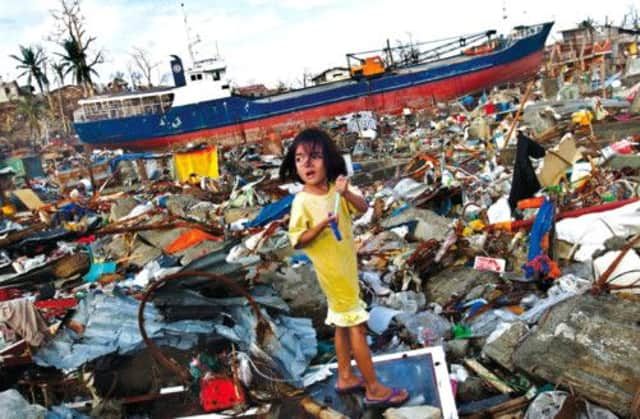Philippines typhoon: President Aquino to make visit


Aquino, who has been blamed for the slow pace of aid distribution and wildly conflicting estimates of casualties, is due to arrive in Tacloban, capital of storm- ravaged Leyte province.
The president’s arrival is expected to coincide with long-delayed emergency supplies flowing into the region, reaching families who had to fend for themselves for days.
Advertisement
Hide AdAdvertisement
Hide AdAs rescuers continued the grim search for victims, some of whom have been missing now for more than a week, the United Nations more than doubled its estimate of the number of homeless across the islands to nearly two million.
The aid effort was still patchy, with relief officials reporting a surge in desperate, hungry survivors trying to leave the coastal city of Ormoc, 65 miles west of Tacloban, the worst-affected major city.
More than a week after Typhoon Haiyan killed at least 3,633 people with tree-snapping winds and tsunami-like waves, hundreds of international aid workers set up makeshift hospitals and trucked in supplies.
Residents of Tanauan, a fishing town about nine miles south-east of Tacloban, said they only started receiving substantial aid yesterday after being forced to survive on biscuits and dispose of bodies on their own for days.
More than 60 people were buried behind the municipal office in the district of 50,000 people. Down the road, dozens of corpses were interred under a roundabout.
“I think [the response] was quite slow,” said Penny Tecson, the wife of the district’s mayor. “This town was isolated. Media didn’t come here. We were out of circulation for three days.” She was running the recovery operation while her husband, Pel Tecson, was in Tacloban to coordinate the district’s first large-scale delivery of aid from the national government.
In one ward of Tanauan, neighbourhood chief Cecilio Yepes Jr estimated his community lost nearly 10 per cent of its 1,176 residents. The surge has transformed an entire swampy plain there into a pile of trees and debris. Locals have recovered and buried 30 bodies. Another 98 remain somewhere in the vast wasteland that stretches on either side of the road.
At least 800 people died in the district of Palo, between Tanauan and Tacloban, national authorities said.
Advertisement
Hide AdAdvertisement
Hide AdIn Tacloban, work crews and heavy equipment cleared debris from roadsides, but side streets remained piled with the sodden, tangled remains of homes, which city officials fear could reveal hundreds more bodies when they are eventually cleared.
There are 1,179 people missing, according to the national count. The official death toll only rose by 12 yesterday, giving hope that initial local estimates of 10,000 dead were overblown.
In front of Tacloban’s San Fernando Elementary School, government workers distributed sacks of aid to a restless crowd of hundreds who had spent the last week camped in shattered wooden classrooms or in a main school building with floors covered in wet black sand. Nearby, about a dozen body bags were lined up by the roadside.
Rica Mobilla, an 18-year-old mother of one, said local authorities showed up two days after the disaster, handing out 4kg of rice and a few packs of noodles for her family of 13. The family stretched this out with onions and garlic from the market.
“I’m upset. I’m not blaming anyone. If there’s aid there to give out, we’ll receive it,” she said.
In Tacloban the death toll is written on a whiteboard at city hall and bodies have been buried in mass graves since Thursday. Tacloban mayor Alfred Romualdez said many people may have been swept out to sea after the tsunami-like wall of seawater slammed into coastal areas.
Yesterday the Philippines social welfare and development secretary Corazon Soliman told a radio station: “We will double our efforts to distribute relief goods because we’ve been hearing complaints that a lot of people have yet to receive relief goods.”
SEE ALSO: